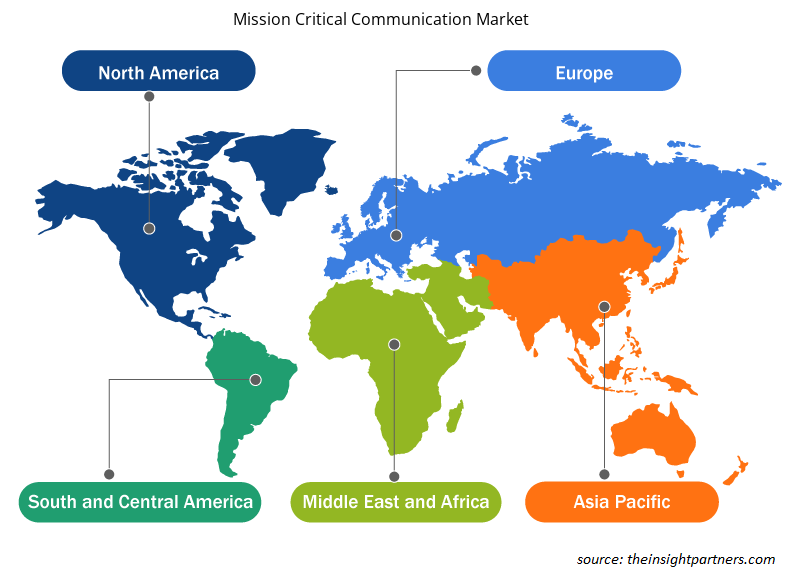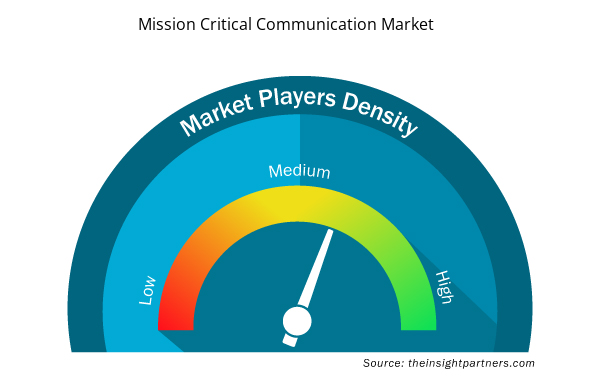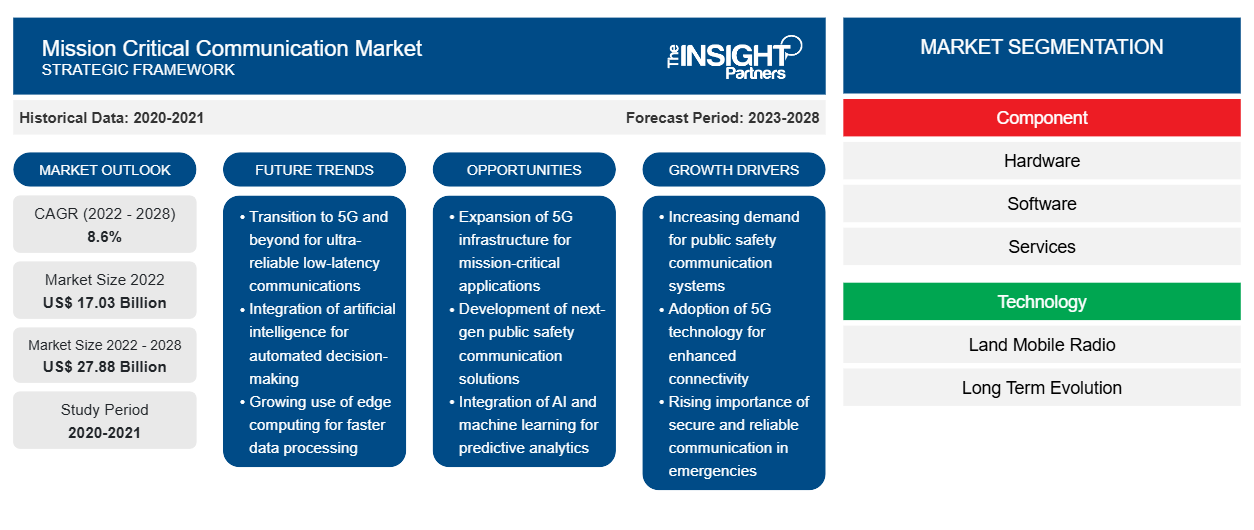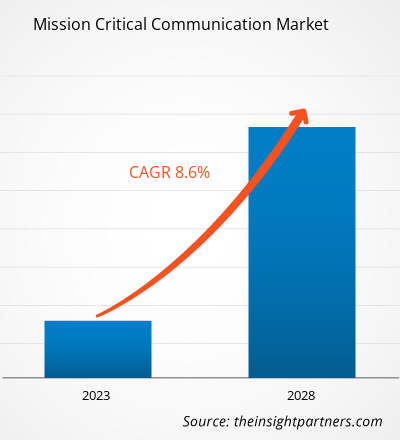关键任务通信市场预计将从 2022 年的 170.3156 亿美元增长到 2028 年的 278.7668 亿美元;预计 2022 年至 2028 年的复合年增长率为 8.6%。
当传统网络无法满足需求时,关键任务通信是提供通信方法的方法。这在大型公共活动中很常见,因为成千上万的移动用户同时使用网络,大多数公共通信网络无法承受如此强度而不崩溃。传统蜂窝网络也会在受灾地区或公共安全危机中失效,导致现场急救人员失去通信系统。关键任务通信在石油和天然气部门、海岸警卫队部门、国土安全部门、运输行业、无人驾驶汽车等行业也很重要。
恐怖主义、边境紧张局势、自然灾害、对称战争、叛乱事件激增;重大紧急情况下的跨境通信;通信基础设施受损;各种安全关键任务,如起重作业、进入密闭空间、应急响应;需要建立不同方之间的协调,对任务关键型通信的需求将会增加。此外,任务关键型网络和基础设施系统提供更好的宽带连接、移动性、互操作性和安全性。
定制此报告以满足您的需求
您可以免费定制任何报告,包括本报告的部分内容、国家级分析、Excel 数据包,以及为初创企业和大学提供优惠和折扣
- 获取此报告的关键市场趋势。这个免费样品将包括数据分析,从市场趋势到估计和预测。
COVID-19 疫情对关键任务通信市场的影响
由于供应链活动中断以及疫情期间对国际贸易的限制,COVID-19 疫情阻碍了关键任务通信市场的增长。不利的经济活动条件导致关键任务通信硬件制造基地的运营短暂停止。因此,几家主要的零部件供应商和技术提供商将重点转向降低成本和缩减制造活动。然而,由于对电子产品的需求不间断,关键任务通信市场增长中的公司可能会在 2021 年的复苏期内恢复运营。
市场洞察 – 关键任务通信市场
根据地理位置,关键任务通信市场分为北美、欧洲、亚太地区 (APAC)、中东和非洲 (MEA) 和南美 (SAM)。欧洲在 2021 年占据最大市场份额,而亚太地区预计在预测期内实现最高复合年增长率。
根据欧盟机构的数据,网络攻击数量从 2019 年的 432 起增加到 2020 年的 756 起。任务关键型通信系统在检测和预防网络攻击方面发挥着至关重要的作用。BroadNet——欧洲公共安全计划的重点是采用可以从远程位置操作的安全任务关键型宽带通信,以确保各国的安全。因此,随着网络攻击案件的增加,安全威胁的增加以及政府为安全目的采用先进通信解决方案的举措,预计将在未来几年为欧洲任务关键型通信市场份额创造丰厚的机会。
在欧洲,瑞典、荷兰和瑞士等国家正在大力投资建设发电厂,以减少碳足迹。这些因素进一步促进了市场的增长。此外,预计该地区新产品的推出将进一步推动关键任务通信市场的增长。例如,2019 年 4 月,在最近开放的 410-430 MHz 频段,诺基亚和北欧电信建立了世界上第一个支持关键任务通信 (MCC) 的 LTE 网络。捷克运营商北欧电信将能够加快公共安全和救灾活动,这要归功于诺基亚尖端且面向未来的移动宽带解决方案,该解决方案支持只能在移动宽带网络上实现的新服务。上述国家的工业发展将有助于推动关键任务通信市场的增长。
基于技术的见解
根据技术,关键任务通信市场分为陆地移动无线电和 LTE。LTE 部分在 2021 年占据了更大的关键任务通信市场份额。LTE 是一种 4G 无线标准,可提高手机以及其他蜂窝设备的网络容量和速度。除了更低的延迟和可扩展的带宽容量外,它还与现有的全球移动通信系统和通用移动电信服务技术具有向后兼容性。
关键任务通信市场规模已根据组件、技术、垂直行业和地理位置进行了细分。根据组件,关键任务通信市场规模细分为硬件、软件和服务。根据技术,市场分析分为 LTE 和陆地移动无线电。根据垂直行业,市场分析分为公共安全和政府机构、交通、能源和公用事业、采矿等。根据地理位置,市场主要细分为北美、欧洲、亚太地区 (APAC)、中东和非洲 (MEA) 和南美。
Telefonaktiebolaget LM Ericsson、Thales Group、Motorola Solutions、L3Harris Technologies, Inc. 和 Hytera Communications Corporation Ltd. 是一些主要的市场参与者。关键任务通信市场高度分散,几个参与者都集中在特定地区,这使得他们专注于满足国内需求。
关键任务通信市场区域洞察
Insight Partners 的分析师已详尽解释了预测期内影响关键任务通信市场的区域趋势和因素。本节还讨论了北美、欧洲、亚太地区、中东和非洲以及南美和中美洲的关键任务通信市场细分和地理位置。

- 获取关键任务通信市场的区域特定数据
关键任务通信市场报告范围
| 报告属性 | 细节 |
|---|---|
| 2022 年市场规模 | 170.3亿美元 |
| 2028 年市场规模 | 278.8亿美元 |
| 全球复合年增长率(2022 - 2028) | 8.6% |
| 史料 | 2020-2021 |
| 预测期 | 2023-2028 |
| 涵盖的领域 | 按组件
|
| 覆盖地区和国家 | 北美
|
| 市场领导者和主要公司简介 |
|
市场参与者密度:了解其对商业动态的影响
关键任务通信市场正在快速增长,这得益于最终用户需求的不断增长,而这些需求又源于消费者偏好的不断变化、技术进步以及对产品优势的认识不断提高等因素。随着需求的增加,企业正在扩大其产品范围,进行创新以满足消费者的需求,并利用新兴趋势,从而进一步推动市场增长。
市场参与者密度是指在特定市场或行业内运营的企业或公司的分布情况。它表明在给定市场空间中,相对于其规模或总市场价值,有多少竞争对手(市场参与者)存在。
在关键任务通信市场运营的主要公司有:
- 阿斯康
- 海能达通信股份有限公司
- 华为技术有限公司
- L3Harris 技术公司
- 摩托罗拉系统公司
免责声明:上面列出的公司没有按照任何特定顺序排列。

- 获取关键任务通信市场顶级关键参与者概览
关键任务通信市场参与者主要专注于开发先进、高效的产品。
- 2022 年,L3Harris Technologies 在国际无线通信博览会 (IWCE) 上宣布其 15 款 XL 系列无线电设备采用任务关键型一键通 (MCPTT) 标准。MCPTT 将在 XL 系列设备中展出,这些设备可实现与消防、执法和紧急医疗服务的全国互操作性
- 2022年,全球专业通信技术与解决方案领导者海能达举办线上发布会,发布对下一代关键业务通信的探索与洞察,发布《融合原生下一代关键业务网络白皮书》及多款产品,开创关键业务行业“混合”时代。
- 2021 年,CTS 与总部位于德国的无线网络任务关键型通信先驱 TASSTA 宣布建立新的战略联盟,将 CTS 在 CBRS 频谱上运行的私有 4G LTE 和 5G 无线网络与 TASSTA 的任务关键型一键通通信解决方案相结合。
- 历史分析(2 年)、基准年、预测(7 年)及复合年增长率
- PEST 和 SWOT 分析
- 市场规模价值/数量 - 全球、区域、国家
- 行业和竞争格局
- Excel 数据集



Report Coverage
Revenue forecast, Company Analysis, Industry landscape, Growth factors, and Trends

Segment Covered
This text is related
to segments covered.

Regional Scope
North America, Europe, Asia Pacific, Middle East & Africa, South & Central America

Country Scope
This text is related
to country scope.
常见问题
The US, the UK, India, UAE, and Brazil are the countries registering a high growth rate during the forecast period.
Asia Pacific is expected to witness the fastest growing CAGR in the global mission critical communication market over the forecast period.
Integration of Advanced Technologies to Enhance Mission Critical Communication Solution Efficiency
The major companies in the mission critical communication market include Telefonaktiebolaget LM Ericsson; Thales Group; L3Harris Technologies, Inc.; Motorola Solutions; and Hytera Communications Corporation Ltd.
• Increase in Adoption of Mission Critical Communication Systems from Energy & Utility Sector
• Rise in Investments in New Product Initiative by Global Players
The global market size for the mission critical communication market is US$ 17,031.56 million in 2022.
Trends and growth analysis reports related to Electronics and Semiconductor : READ MORE..
The List of Companies - Mission Critical Communication Market
- Ascom
- Hytera Communication Corporation Limited
- Huawei Technologies Co. Ltd.
- L3Harris Technologies, Inc.
- Motorola Solutions, Inc.
- Mentura Group OY
- Nokia Corporation
- Telefonaktiebolaget LM Ericsson
- Tassta GmbH
- Zenitel
The Insight Partners performs research in 4 major stages: Data Collection & Secondary Research, Primary Research, Data Analysis and Data Triangulation & Final Review.
- Data Collection and Secondary Research:
As a market research and consulting firm operating from a decade, we have published and advised several client across the globe. First step for any study will start with an assessment of currently available data and insights from existing reports. Further, historical and current market information is collected from Investor Presentations, Annual Reports, SEC Filings, etc., and other information related to company’s performance and market positioning are gathered from Paid Databases (Factiva, Hoovers, and Reuters) and various other publications available in public domain.
Several associations trade associates, technical forums, institutes, societies and organization are accessed to gain technical as well as market related insights through their publications such as research papers, blogs and press releases related to the studies are referred to get cues about the market. Further, white papers, journals, magazines, and other news articles published in last 3 years are scrutinized and analyzed to understand the current market trends.
- Primary Research:
The primarily interview analysis comprise of data obtained from industry participants interview and answers to survey questions gathered by in-house primary team.
For primary research, interviews are conducted with industry experts/CEOs/Marketing Managers/VPs/Subject Matter Experts from both demand and supply side to get a 360-degree view of the market. The primary team conducts several interviews based on the complexity of the markets to understand the various market trends and dynamics which makes research more credible and precise.
A typical research interview fulfils the following functions:
- Provides first-hand information on the market size, market trends, growth trends, competitive landscape, and outlook
- Validates and strengthens in-house secondary research findings
- Develops the analysis team’s expertise and market understanding
Primary research involves email interactions and telephone interviews for each market, category, segment, and sub-segment across geographies. The participants who typically take part in such a process include, but are not limited to:
- Industry participants: VPs, business development managers, market intelligence managers and national sales managers
- Outside experts: Valuation experts, research analysts and key opinion leaders specializing in the electronics and semiconductor industry.
Below is the breakup of our primary respondents by company, designation, and region:

Once we receive the confirmation from primary research sources or primary respondents, we finalize the base year market estimation and forecast the data as per the macroeconomic and microeconomic factors assessed during data collection.
- Data Analysis:
Once data is validated through both secondary as well as primary respondents, we finalize the market estimations by hypothesis formulation and factor analysis at regional and country level.
- Macro-Economic Factor Analysis:
We analyse macroeconomic indicators such the gross domestic product (GDP), increase in the demand for goods and services across industries, technological advancement, regional economic growth, governmental policies, the influence of COVID-19, PEST analysis, and other aspects. This analysis aids in setting benchmarks for various nations/regions and approximating market splits. Additionally, the general trend of the aforementioned components aid in determining the market's development possibilities.
- Country Level Data:
Various factors that are especially aligned to the country are taken into account to determine the market size for a certain area and country, including the presence of vendors, such as headquarters and offices, the country's GDP, demand patterns, and industry growth. To comprehend the market dynamics for the nation, a number of growth variables, inhibitors, application areas, and current market trends are researched. The aforementioned elements aid in determining the country's overall market's growth potential.
- Company Profile:
The “Table of Contents” is formulated by listing and analyzing more than 25 - 30 companies operating in the market ecosystem across geographies. However, we profile only 10 companies as a standard practice in our syndicate reports. These 10 companies comprise leading, emerging, and regional players. Nonetheless, our analysis is not restricted to the 10 listed companies, we also analyze other companies present in the market to develop a holistic view and understand the prevailing trends. The “Company Profiles” section in the report covers key facts, business description, products & services, financial information, SWOT analysis, and key developments. The financial information presented is extracted from the annual reports and official documents of the publicly listed companies. Upon collecting the information for the sections of respective companies, we verify them via various primary sources and then compile the data in respective company profiles. The company level information helps us in deriving the base number as well as in forecasting the market size.
- Developing Base Number:
Aggregation of sales statistics (2020-2022) and macro-economic factor, and other secondary and primary research insights are utilized to arrive at base number and related market shares for 2022. The data gaps are identified in this step and relevant market data is analyzed, collected from paid primary interviews or databases. On finalizing the base year market size, forecasts are developed on the basis of macro-economic, industry and market growth factors and company level analysis.
- Data Triangulation and Final Review:
The market findings and base year market size calculations are validated from supply as well as demand side. Demand side validations are based on macro-economic factor analysis and benchmarks for respective regions and countries. In case of supply side validations, revenues of major companies are estimated (in case not available) based on industry benchmark, approximate number of employees, product portfolio, and primary interviews revenues are gathered. Further revenue from target product/service segment is assessed to avoid overshooting of market statistics. In case of heavy deviations between supply and demand side values, all thes steps are repeated to achieve synchronization.
We follow an iterative model, wherein we share our research findings with Subject Matter Experts (SME’s) and Key Opinion Leaders (KOLs) until consensus view of the market is not formulated – this model negates any drastic deviation in the opinions of experts. Only validated and universally acceptable research findings are quoted in our reports.
We have important check points that we use to validate our research findings – which we call – data triangulation, where we validate the information, we generate from secondary sources with primary interviews and then we re-validate with our internal data bases and Subject matter experts. This comprehensive model enables us to deliver high quality, reliable data in shortest possible time.


 获取此报告的免费样本
获取此报告的免费样本